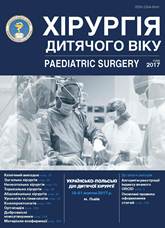Our experience of treatment a newborn with ichthyosiform erythroderma
DOI:
https://doi.org/10.15574/PS.2017.56.31Keywords:
ichthyosiform erythroderma, bullous ichthyosiform erythroderma, wound coveringsAbstract
Introduction. Severe forms of ichthyosis often occur in the practice of intensive neonatology, among all genodermatosis: fetus ichthyosis (lamellar ichthyosis) and ichthyosiform bullous erytroderma (Broca).Objective. To improve the treatment outcomes in patients with congenital ihtiotises using burn technology.
Material and methods. The analysis of treatment outcomes in 5 newborns with severe bullous ichthyosis erythroderma and lamellar ichthyosis in Mykolaiv Regional Children’s Hospital during 2009-2017 was carried out. In local treatment of diffused cutaneous lesions combustiologists were engaged, who offered approaches as in the treatment of superficial dermal burns with mesh and film wound coatings.
Results. The treatment modality in children with ichthyosoform erythroderma included: infusion therapy at rate of 100-110 ml/kg/day; systemic antibiotic therapy; hormone therapy; probe enteral nutrition; passive non-specific immunization; respiratory support. Local treatment: daily replacement of the bandage under the intravenous combined anesthesia with the use of film and paraffinized mesh wound coats. The wounds were covered with thermosaving bandages.
Conclusions. 1. The use of modern wound dressing for local treatment, systemic antibiotic therapy against the background of general intensive care methods allowed to avoid the development of infectious complications and optimize the course of the wound process. 2. Implementation of the medical treatment plan for patients with ichthyosis allowed to create a database of patients, to improve medical care, involving the specialists of treatment of wounds – combustiologists – for the treatment of these children.
References
Wulf K, Johnson R, Syurmond DM. (2007). Dermatology according to Thomas Fitzpatrick. Trans. with the English. Praktika: 118-127.
Katsambas AD, Lottie ТМ. (2008). The European guide to the treatment of dermatological diseases. М, MEDpress-inform: 736.
Kryuchko TO, Peshiy MM, Pokhilko VI, Tkachenko AYa, Goncharova YuO. (2012). Ichthyosis in children. Congenital ichthyosiform erythroderma Broca. Neonatology, Surgery and Perinatal Medicine. ІІ;1(3): 110-114.
Kovalenko OM. (2012, Feb). Tactics of treatment for extended burns of various affection depth. Klin Khir. (2): 52-6.
Blanchet-Bardon C, Tadini G, Machado Matos M, Delarue A. (2012, Aug). Association of glycerol and paraffin in the treatment of ichthyosis in children: an international, multicentric, randomized, controlled, double-blind study. J Eur Acad Dermatol Venereol. 26(8): 1014-9. https://doi.org/10.1111/j.1468-3083.2011.04304.x. Epub 2011 Nov 28.
Dahlqvist J1, Klar J, Hausser I, Anton-Lamprecht I, Pigg MH, Gedde-Dahl TJr, Gånemo A, Vahlquist A, Dahl N. (2007, Oct). Congenital ichthyosis: mutations in ichthyin are associated with specific structural abnormalities in the granular layer of epidermis. J Med Genet. 44(10): 615-20. https://doi.org/10.1136/jmg.2007.050542; PMid:17557927 PMCid:PMC2597970
Fischer J. (2009, Jun). Autosomal recessive congenital ichthyosis. J Invest Dermatol. 129(6): 1319-21. https://doi.org/10.1038/jid.2009.57.
Kusakabe M1, Nagai M, Nakano E, Jitsukawa O, Nishigori C, Yamanishi K. (2017, Mar). A Japanese Case of Ichthyosiform Erythroderma with a Novel Mutation in NIPAL4/Ichthyin. Acta Derm Venereol. 10; 97(3): 397-398. doi 10.2340/00015555-2550.
Lefévre C, Audebert S, Jobard F, Bouadjar B, Lakhdar H, Boughdene-Stambouli O, Blanchet-Bardon C, Heilig R, Foglio M, Weissenbach J, Lathrop M, Prud'homme JF, Fischer J. (2003, Sep). Mutations in the transporter ABCA12 are associated with lamellar ichthyosis type 2. Hum Mol Genet. 15; 12(18): 2369-78.
Basgul AY, Kavak ZN, Guducu N, Durukan B, Isci H. (2011). Prenatal diagnosis of congenital harlequin ichthyosis with 2D, 3D, and 4D ultrasonography. Clin Exp Obstet Gynecol. 38(3): 283-5. PMid:21995167
Oji V, Tadini G, Akiyama M, Blanchet Bardon C, Bodemer C, Bourrat E, Coudiere P, DiGiovanna JJ, Elias P, Fischer J, Fleckman P, Gina M, Harper J et al. (2010, Oct). Revised nomenclature and classification of inherited ichthyoses: results of the First Ichthyosis Consensus Conference in Sorèze 2009. J Am Acad Dermatol. 63(4): 607-41. https://doi.org/10.1016/j.jaad.2009.11.020.
Bodemer C, Bourrat E, Mazereeuw-Hautier J, Boralevi F, Barbarot S, Bessis D, Blanchet-Bardon C, Bourdon-Lanoy E, Stalder JF, Ribet V, Guerrero D, Sibaud V. (2011, Nov). Short- and medium-term efficacy of specific hydrotherapy in inherited ichthyosis. Br J Dermatol. 165(5): 1087-94. https://doi.org/10.1111/j.1365-2133.2011.10510.x.
Pigg MH, Bygum A, Gånemo A, Virtanen M, Brandrup F, Zimmer AD, Hotz A, Vahlquist A, Fischer J. (2016, Nov). Spectrum of Autosomal Recessive Congenital Ichthyosis in Scandinavia: Clinical Characteristics and Novel and Recurrent Mutations in 132 Patients. Acta Derm Venereol. 2; 96(7): 932-937. doi 10.2340/00015555-2418.
Downloads
Issue
Section
License
The policy of the Journal “PAEDIATRIC SURGERY. UKRAINE” is compatible with the vast majority of funders' of open access and self-archiving policies. The journal provides immediate open access route being convinced that everyone – not only scientists - can benefit from research results, and publishes articles exclusively under open access distribution, with a Creative Commons Attribution-Noncommercial 4.0 international license(СС BY-NC).
Authors transfer the copyright to the Journal “PAEDIATRIC SURGERY.UKRAINE” when the manuscript is accepted for publication. Authors declare that this manuscript has not been published nor is under simultaneous consideration for publication elsewhere. After publication, the articles become freely available on-line to the public.
Readers have the right to use, distribute, and reproduce articles in any medium, provided the articles and the journal are properly cited.
The use of published materials for commercial purposes is strongly prohibited.

